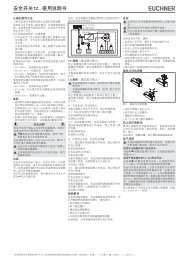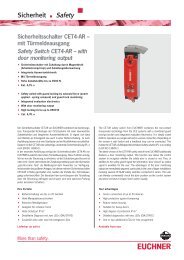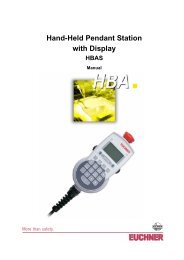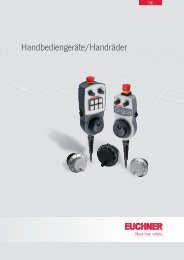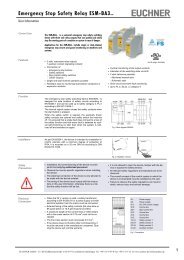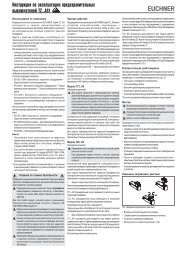2318 KB - EUCHNER GmbH + Co. KG
2318 KB - EUCHNER GmbH + Co. KG
2318 KB - EUCHNER GmbH + Co. KG
You also want an ePaper? Increase the reach of your titles
YUMPU automatically turns print PDFs into web optimized ePapers that Google loves.
More than safety.<br />
Operating Instructions<br />
Non-<strong>Co</strong>ntact Safety Switch with Guard Locking<br />
CET.-AP-...-AH-... (Unicode)
Operating Instructions Safety Switch CET.-AP-...-AH-...<br />
<strong>Co</strong>ntents<br />
Scope 3<br />
<strong>Co</strong>rrect use 3<br />
Possible combinations for CES components 4<br />
Exclusion of liability and warranty 4<br />
General safety instructions 5<br />
Function 6<br />
Function of the electronics 6<br />
Function of the guard locking 8<br />
Mechanical release and mechanical key release (can be retrofitted) 9<br />
Emergency unlocking (can be retrofitted) 10<br />
Escape release (optional) 11<br />
Wire front release (optional) 12<br />
Lockout mechanism (optional) 13<br />
Changing the approach direction 14<br />
Mounting 15<br />
Electrical connection 17<br />
Notes for operation with safe control systems 18<br />
Devices for direct connection IP65 field modules 19<br />
Safety in case of faults 19<br />
Fuse protection for power supply 19<br />
Requirements for connection cables 20<br />
<strong>Co</strong>nnector assignment of safety switch CET-AP with 2 x M12 plug connectors, 5-pin and 8-pin 21<br />
<strong>Co</strong>nnector assignment of safety switch CET-AP for connection to decentralized peripheral systems<br />
(2x M12, 5-pin, pin 5 not used) 21<br />
<strong>Co</strong>nnecting the CET-AP (general) 22<br />
<strong>Co</strong>nnecting a CET-AP to a decentralized peripheral system (e.g. ET200 series from Siemens) 23<br />
Setup 24<br />
LED indicators 24<br />
Teach-in function for actuator 24<br />
Functional check 26<br />
System status table 27<br />
Technical data 28<br />
Technical data for safety switch CET.-AP-C..-AH-... 28<br />
Dimension drawing safety switch CET.-AP-... 30<br />
Technical data for actuator CET-A-BWK-50X 32<br />
Ordering information and accessories 33<br />
Versions for connection to decentralized peripheral systems (2 x M12, 5-pin, pin 5 not used) 33<br />
<strong>Co</strong>nnection cables for connection to decentralized peripheral systems 33<br />
Accessories 33<br />
Inspection and service 34<br />
Service 35<br />
Declaration of conformity 36<br />
2
Operating Instructions Safety Switch CET.-AP-...-AH-...<br />
Scope<br />
<strong>Co</strong>rrect use<br />
These operating instructions are valid for all CET.-AP-...-AH-... versions. These<br />
operating instructions and the enclosed data sheet form the complete user information<br />
for your device.<br />
The safety switch CET-AP is an electromagnetic interlock device with guard locking.<br />
In combination with a safety guard and the machine control, this safety component<br />
prevents the safety guard from being opened while a dangerous machine movement<br />
is being performed.<br />
For the control system, this means that<br />
ÌÌstarting commands which cause hazardous situations must become active<br />
only when the safety guard is in protective position and the guard locking is<br />
in locked position. The locked position of the guard locking must be released<br />
only when the hazardous situation is no longer present.<br />
Before safety components are used, a risk assessment must be performed on the<br />
machine in accordance with<br />
ÌÌEN ISO 13849-1, Safety of machinery. Safety related parts of control systems.<br />
General principles for design, Annex B<br />
ÌÌEN ISO 12100, Safety of machinery – General principles for design – Risk assessment<br />
and risk reduction.<br />
ÌÌIEC 62061, Safety of machinery - Functional safety of safety-related electrical,<br />
electronic and programmable electronic control systems<br />
<strong>Co</strong>rrect use includes compliance with the relevant requirements for installation<br />
and operation, in particular<br />
ÌÌEN ISO 13849-1, Safety of machinery. Safety related parts of control systems.<br />
General principles for design<br />
ÌÌEN 1088, Safety of machinery. Interlocking devices associated with guards.<br />
Principles for design and selection<br />
ÌÌEN 60204-1, Electrical equipment of machines<br />
The safety switch is only allowed to be operated in conjunction with the intended<br />
<strong>EUCHNER</strong> CET actuators and the related connection components from <strong>EUCHNER</strong>.<br />
On the use of different actuators or other connection components, <strong>EUCHNER</strong><br />
provides no warranty for safe function.<br />
Important:<br />
ÌÌThe user is responsible for the integration of the device into a safe overall<br />
system. For this purpose, the overall system must be validated, e.g. in accordance<br />
with EN ISO 13849-2.<br />
ÌÌ<strong>Co</strong>rrect use requires observing the permissible operating parameters (see<br />
Technical data).<br />
ÌÌIf a product data sheet is included with the product, the information on the<br />
data sheet applies in case of discrepancies with the operating instructions.<br />
ÌÌIt is only allowed to use components that are permissible in accordance with<br />
the table below.<br />
3
Operating Instructions Safety Switch CET.-AP-...-AH-...<br />
Possible combinations for CES components<br />
Actuator<br />
Safety switch<br />
CET-A-BWK-50X<br />
096327<br />
CET.-AP-...-AH-...<br />
Key to symbols<br />
<strong>Co</strong>mbination possible<br />
Exclusion of liability and warranty<br />
In case of failure to comply with the conditions for correct use stated above, or<br />
if the safety instructions are not followed, or if any servicing is not performed as<br />
required, liability will be excluded and the warranty void.<br />
4
Operating Instructions Safety Switch CET.-AP-...-AH-...<br />
General safety instructions<br />
Warning!<br />
Important:<br />
Safety switches fulfill personal protection functions. Incorrect installation or tampering<br />
can lead to fatal injuries to personnel.<br />
Check the safe function of the safety guard particularly<br />
ÌÌafter any setup work<br />
ÌÌafter the replacement of a CET component<br />
ÌÌafter an extended period without use<br />
ÌÌafter every fault<br />
Independent of these checks, the safe function of the safety guard should be<br />
checked at suitable intervals as part of the maintenance schedule.<br />
Danger of fatal injury in the event of incorrect connection or incorrect use.<br />
ÌÌSafety switches must not be bypassed (bridging of contacts), turned away,<br />
removed or otherwise rendered ineffective. On this topic pay attention in<br />
particular to the measures for reducing the possibility of bypassing from<br />
EN 1088:1995+A2:2008, Section 5.7.<br />
The device is only allowed to be installed and placed in operation by authorized<br />
personnel<br />
ÌÌwho are familiar with the correct handling of safety components<br />
ÌÌwho are familiar with the applicable EMC regulations<br />
ÌÌwho are familiar with the applicable regulations on health and safety and accident<br />
prevention<br />
ÌÌwho have read and understood the operating instructions.<br />
Prior to use, read the operating instructions and keep these in a safe place.<br />
Ensure that the operating instructions are always available during mounting,<br />
setup and servicing work. <strong>EUCHNER</strong> cannot provide any warranty in relation to<br />
the readability of the CD for the storage period required. For this reason you<br />
should archive a printed copy of the operating instructions. You can download<br />
the operating instructions from www.<strong>EUCHNER</strong>.de.<br />
5
Operating Instructions Safety Switch CET.-AP-...-AH-...<br />
Function<br />
Function of the electronics<br />
Recess<br />
Lift tappet<br />
Slide<br />
Transponder<br />
Spring-mounted guard locking<br />
pin<br />
Safety switches series CET-AP permit locking of movable safety guards. They meet<br />
the following safety requirements:<br />
ÌÌCategory 3, PLe according to EN ISO 13849-1 (head mounted upward)<br />
ÌÌCategory 4, PLe according to EN ISO 13849-1 (head mounted downward or<br />
horizontal)<br />
ÌÌRedundant design of the circuit in the unit with self-monitoring<br />
ÌÌThis means that the safety system still functions even if an internal component<br />
fails<br />
ÌÌThe switch state of the semiconductor outputs is continuously monitored internally<br />
ÌÌShort circuit detection at the safety outputs by pulse signals<br />
The following switch-on condition applies to safety outputs OA and OB (see also<br />
System status table and the section Typical system times):<br />
ÌÌSafety guard closed<br />
ÌÌGuard locking active (actuator completely inserted into recess)<br />
ÌÌFeedback loop closed (only for version with feedback loop/start button)<br />
The system consists of the following components: coded actuator (transponder)<br />
and switch.<br />
Each actuator has a unique electronic coding and is therefore a unique element.<br />
The code in an actuator cannot be reprogrammed.<br />
The actuator must be assigned to the safety switch by a teach-in process so that<br />
it is detected by the system. This unambiguous assignment ensures a particularly<br />
high level of protection against tampering.<br />
The safety switch with integrated evaluation unit and read head is fastened to the<br />
fixed part of the safety guard.<br />
The actuator attached to the movable part of the safety guard is moved towards<br />
the read head fitted in the safety switch by closing the door. When the switch-on<br />
distance is reached, power is supplied to the actuator by the inductive read head<br />
and data can be transferred.<br />
The bit pattern read is compared with the code saved in the safety switch. If the<br />
data match, the safety outputs are enabled. On devices with monitoring output<br />
(OUT), this is also switched off.<br />
Due to the combination of dynamic polling of the actuator and the redundant,<br />
diverse design of the safety electronics with the two feedback safety outputs, the<br />
safety switch will enter the safe state with every detectable fault.<br />
The safety outputs shut down the safety circuit if the safety guard is opened. On<br />
devices with monitoring output (OUT), this is switched on. The state of the safety<br />
outputs is monitored internally by two microprocessors.<br />
In the event of a fault in the safety switch, the safety circuit is switched off and<br />
the DIA LED illuminates red.<br />
The safety switch has a redundant circuit design with self-monitoring. This means<br />
that the safety system is still effective even if a component fails.<br />
6
Operating Instructions Safety Switch CET.-AP-...-AH-...<br />
The system is designed so that failures will not result in the loss of the safety function.<br />
The occurrence of failures is detected by cyclic self-monitoring at the latest<br />
on the next demand to close the safety contacts (e.g. on starting).<br />
7
Operating Instructions Safety Switch CET.-AP-...-AH-...<br />
Function of the guard locking<br />
Version CET1-AP, guard locking by spring force<br />
The lift tappet is pressed into the locked position by the force of the spring for the<br />
guard locking pin in the actuator and unlocked electromagnetically by the safety<br />
switch. The guard locking functions in accordance with the closed-circuit current<br />
principle. The locked safety guard cannot be opened immediately in the event of<br />
interruption of the power supply to the solenoid.<br />
The guard locking pin of the actuator cannot be moved out of the recess and the<br />
door is locked in the closed position as long as the lift tappet is pressed down by<br />
the actuator.<br />
When the operating voltage is present at the locking solenoid, the lift tappet is<br />
extended and lifts the actuator's guard locking pin above the edge of the recess.<br />
The safety door can then be opened.<br />
Important:<br />
Version CET2-AP, guard locking by solenoid force<br />
The safety guard can be opened immediately in the event of interruption of the<br />
solenoid power supply! Usage only in special cases in accordance with strict<br />
evaluation of the accident risk (see DIN EN 1088 (1995), section 5.5)!<br />
Example: If the risk of accidental locking inside a safety guard during a power<br />
failure is higher than the risk of ineffective guard locking.<br />
The lift tappet is held in locked position by electromagnetic force and released<br />
by spring force. The guard locking operates in accordance with the open-circuit<br />
current principle.<br />
The safety door can be opened as long as the lift tappet is held in the extended<br />
position.<br />
The lift tappet is released when operating voltage is present at the guard locking<br />
solenoid. The actuator's guard locking pin can now press the lift tappet down.<br />
The safety door is locked as soon as the guard locking pin is fully inserted into<br />
the recess.<br />
Version CET3-AP, guard locking by spring force with door monitoring<br />
output<br />
Function as for CET1-AP, but the door position is also monitored here. The door<br />
monitoring output OUT D is switched on as soon as the actuator protrudes beyond<br />
the extended lift tappet (state: door closed, guard locking not active). The output<br />
OUT D also remains switched on when guard locking is active.<br />
Devices for connection to decentralized peripheral systems do not feature a door<br />
monitoring output OUT D. Instead, the door position is indicated via LED 2.<br />
Version CET4-AP, guard locking by solenoid force with door monitoring<br />
output<br />
Function as for CET2-AP, but the door position is also monitored here. The door<br />
monitoring output OUT D is switched on as soon as the actuator protrudes beyond<br />
the extended lift tappet (state: door closed, guard locking not active). The output<br />
OUT D also remains switched on when guard locking is active.<br />
Devices for connection to decentralized peripheral systems do not feature a door<br />
monitoring output OUT D. Instead, the door position is indicated via LED 2.<br />
8
Operating Instructions Safety Switch CET.-AP-...-AH-...<br />
Important:<br />
Mechanical release and mechanical key release<br />
(can be retrofitted)<br />
ÌÌThe mechanical release is not a safety function.<br />
ÌÌThe machine manufacturer must select and use a suitable release (escape<br />
release, emergency unlocking, etc.) for a specific application. A risk assessment<br />
appraisal is required for this purpose. It may be necessary to take<br />
specifications from a product standard into account.<br />
ÌÌThe mechanical key 5,8release must not be used to lock the switch during maintenance<br />
work to prevent activation of guard locking, for example.<br />
ÌÌThe correct function must be checked at regular intervals.<br />
ÌÌLoss of the release function due to mounting errors or damage during<br />
mounting.<br />
ÌÌCheck the release function every time after mounting.<br />
ÌÌLoss 30 of the release function 16,7due to tension on the actuator. The door must<br />
not be under tension during release.<br />
ÌÌPlease observe the notes on any enclosed data sheets.<br />
35,5<br />
20<br />
Ø<br />
The mechanical release can be used to unlock guard locking, irrespective of the<br />
state of the solenoid.<br />
Using mechanical release<br />
1. Unscrew locking screw<br />
2. Using a screwdriver, turn the mechanical release by around 180° in the direction<br />
of the arrow<br />
¨¨<br />
The safety device can be opened<br />
The mechanical release must be returned to its original position and sealed after<br />
use (for example with sealing lacquer).<br />
Using mechanical key release<br />
On devices with mechanical key release (can be retrofitted), simply turn the key to<br />
unlock. For mounting, see the mechanical key release supplement.<br />
On devices with monitoring output OUT, this is switched off; OUT D can assume<br />
an undefined state. Open the safety door and close it again after resetting the<br />
mechanical release. The device will then operate normally again.<br />
9
Operating Instructions Safety Switch CET.-AP-...-AH-...<br />
Important:<br />
Emergency unlocking (can be retrofitted)<br />
ÌÌEmergency unlocking is not a safety function.<br />
ÌÌThe machine manufacturer must select and use a suitable release (escape<br />
release, emergency unlocking, etc.) for a specific application. A risk assessment<br />
appraisal is required for this purpose. It may be necessary to take<br />
specifications from a product standard into account.<br />
ÌÌThe correct function must be checked at regular intervals.<br />
ÌÌLoss of the release function due to mounting errors or damage during<br />
mounting.<br />
ÌÌCheck the release function every time after mounting.<br />
ÌÌLoss of the release function due to tension on the actuator. The door must<br />
not be under tension during release.<br />
ÌÌPlease observe the notes on any enclosed data sheets.<br />
Emergency unlocking can be used to unlock guard locking, irrespective of the state<br />
of the solenoid. For mounting, see the mounting supplement.<br />
Important:<br />
Using emergency unlocking<br />
The door must not be under tension when emergency unlocking is actuated.<br />
Detent bolt<br />
ÌÌTurn emergency unlocking clockwise until it clicks into place.<br />
¨¨<br />
The safety device can be opened<br />
To reset, press the detent bolt inward using a small screwdriver or similar tool and<br />
turn the emergency unlocking back.<br />
On devices with monitoring output OUT, this is switched off; OUT D can assume an<br />
undefined state. Open the safety door and close it again after resetting emergency<br />
unlocking. The device will then operate normally again.<br />
71<br />
10
Operating Instructions Safety Switch CET.-AP-...-AH-...<br />
Important:<br />
Escape release (optional)<br />
ÌÌThe escape release is not a safety function.<br />
ÌÌThe machine manufacturer must select and use a suitable release (escape<br />
release, emergency unlocking, etc.) for a specific application. A risk assessment<br />
appraisal is required for this purpose. It may be necessary to take<br />
specifications from a product standard into account.<br />
ÌÌThe correct function must be checked at regular intervals.<br />
ÌÌLoss of the release function due to tension on the actuator. The door must<br />
not be under tension during release.<br />
ÌÌPlease observe the notes on any enclosed data sheets.<br />
The escape release is used to open a locked safety guard from the inside (see<br />
dimension drawing in the section Technical data).<br />
Fit escape release such that operation, inspection and maintenance are possible.<br />
Using the escape release<br />
ÌÌPress the red release knob to the stop<br />
¨¨<br />
The safety device can be opened<br />
Pull the knob out again to reset.<br />
On devices with monitoring output OUT, this is switched off; OUT D can assume an<br />
undefined state. Open the safety door and close it again after resetting the escape<br />
release. The device will then operate normally again.<br />
11
Operating Instructions Safety Switch CET.-AP-...-AH-...<br />
Important:<br />
Wire front release (optional)<br />
ÌÌThe wire front release is not a safety function.<br />
ÌÌThe wire front release is non-latching and therefore must not be used as an<br />
escape release unless the machine manufacturer itself provides a detent<br />
mechanism. The machine manufacturer must select and use a suitable release<br />
(escape release, emergency unlocking, etc.) for a specific application.<br />
A risk assessment appraisal is required for this purpose. It may be necessary<br />
to take specifications from a product standard into account.<br />
ÌÌLoss of the release function due to tension on the actuator. The door must<br />
not be under tension during release.<br />
ÌÌThe correct function must be checked at regular intervals.<br />
The wire front release permits remote release of the guard locking via a pull rope.<br />
Flexible routing of the pull rope permits release of the guard locking in inaccessible<br />
installation situations.<br />
On devices with monitoring output OUT, this is switched off; OUT D can assume an<br />
undefined state. Open the safety door and close it again after resetting the wire<br />
front release. The device will then operate normally again.<br />
Important:<br />
Mounting the wire front release<br />
ÌÌLoss of the release function due to mounting errors, damage or wear.<br />
ÌÌCheck the release function every time after mounting.<br />
ÌÌWhen routing the wire front release, ensure that it operates smoothly.<br />
ÌÌObserve the min. bending radius (100 mm) and minimize the number of<br />
bends.<br />
ÌÌThe switch is not allowed to be opened.<br />
ÌÌObserve the notes on the enclosed data sheets.<br />
12
Operating Instructions Safety Switch CET.-AP-...-AH-...<br />
Important:<br />
Lockout mechanism (optional)<br />
ÌÌThe lockout mechanism is not a safety function.<br />
ÌÌThe correct function must be checked at regular intervals.<br />
The lockout mechanism can be used to prevent maintenance personnel from being<br />
unintentionally locked in the danger area, for example.<br />
In locked position, the lockout mechanism prevents activation of guard locking.<br />
The lockout mechanism can be secured in locking position with up to three locks.<br />
The mechanical release can still be used.<br />
Important:<br />
Using the lockout mechanism<br />
Deactivate guard locking and open the safety door before using the lockout<br />
mechanism.<br />
Before entering the danger area:<br />
1. Open the door<br />
2. Press button, move lockout mechanism to locking position (Figures A and B)<br />
and secure with lock (Figure C)<br />
¨¨<br />
Guard locking cannot be activated, and it must not be possible to start the<br />
machine. Important: Test this before entering the danger area.<br />
Resetting the lockout mechanism:<br />
1. Open the safety door if necessary<br />
2. Remove the lock<br />
3. Move lockout mechanism to basic position (Figure A)<br />
Locking function not active Locking function active Locking function active<br />
and secured<br />
Pushbutton<br />
Push button and align lever<br />
Fit lock<br />
Figure A Figure B Figure C<br />
13
Operating Instructions Safety Switch CET.-AP-...-AH-...<br />
(1)<br />
(2)<br />
Using mechanical release<br />
1. Unscrew locking screw<br />
2. Operate the mechanical release through the threaded bore of the locking<br />
screw (e.g. with a metal rod ∅ 3 mm)<br />
¨¨<br />
The safety device can be opened<br />
The locking screw must be screwed back in and sealed after use (for example<br />
with sealing lacquer).<br />
On devices with monitoring output OUT, this is switched off; OUT D can assume<br />
an undefined state. Open the safety door and close it again after resetting the<br />
mechanical release. The device will then operate normally again.<br />
Changing the approach direction<br />
1. Remove the screws from the safety switch<br />
2. Set the required direction<br />
3. Tighten the screws with a torque of 1.5 Nm.<br />
Figure 1: Changing the approach direction<br />
14
Operating Instructions Safety Switch CET.-AP-...-AH-...<br />
Mounting<br />
Caution!<br />
Caution!<br />
Safety switches must not be bypassed (bridging of contacts), turned away,<br />
removed or otherwise rendered ineffective.<br />
ÌÌOn this topic pay attention in particular to the measures for reducing the possibility<br />
of bypassing according to EN 1088:1995.A2:2008, sec. 5.7.<br />
ÌÌThe max. achievable category according to EN 13849-1 depends on the<br />
installation position (see technical data).<br />
Risk of damage to equipment and malfunctions as a result of incorrect installation.<br />
ÌÌSafety switches must not be used as a mechanical end stop. Fit an additional<br />
end stop for the movable part of the safety guard.<br />
ÌÌObserve the min. door radii (see figure below).<br />
ÌÌEnsure that the actuator contacts the slide in the designated area (see figure<br />
below). Marks on the slide specify the prescribed approach zone.<br />
ÌÌThe prerequisite for trouble-free long-term operation is protection of the<br />
switch head against penetrating foreign objects such as swarf, sand, and<br />
blasting shot, etc. The switch should be installed with the actuating head<br />
down for this purpose.<br />
ÌÌ<strong>Co</strong>ver the switch before painting work.<br />
min R800<br />
min R300<br />
74,5 ± 4 mm<br />
Figure 2: Door radii and approach zone<br />
15
Operating Instructions Safety Switch CET.-AP-...-AH-...<br />
!<br />
= 90°<br />
Note the following points:<br />
ÌÌActuator and safety switch must be easily accessible for inspection and replacement.<br />
ÌÌThe switching operation must only be triggered by the specific actuator designated<br />
for this purpose.<br />
ÌÌActuator and safety switch must be fitted so that<br />
ÌÌthe actuator is positively mounted on the safety guard, e.g. by using the<br />
safety screws included.<br />
ÌÌthey cannot be removed or tampered with using simple means.<br />
ÌÌthe active faces of the actuator and the safety switch are parallel to each<br />
other (see figure on the left).<br />
ÌÌthe actuator is fully inserted into the switch recess when the safety guard is<br />
closed (see figure on the left).<br />
ÌÌno dirt can accumulate in the recess.<br />
!<br />
16
Operating Instructions Safety Switch CET.-AP-...-AH-...<br />
Electrical connection<br />
Warning!<br />
In case of an error, loss of the safety function through incorrect connection.<br />
ÌÌTo ensure safety, both safety outputs (OA and OB) must always be evaluated.<br />
ÌÌThe monitoring output OUT and the door monitoring output OUT D are not<br />
allowed to be used as safety outputs.<br />
ÌÌLay the connection cables with protection to prevent the risk of short circuits.<br />
Caution!<br />
Risk of damage to equipment or malfunctions as a result of incorrect connection.<br />
ÌÌThe power supply for the evaluation electronics is electrically isolated from<br />
the power supply for the guard locking solenoid.<br />
ÌÌThe teach-in input and feedback loop, as well as LED 1 and LED 2 (only applicable<br />
to freely controllable LEDs), have the same ground potential as the<br />
guard locking solenoid.<br />
ÌÌThe device generates its own clock signal on the output lines OA/OB. A<br />
downstream control system must tolerate these pulses, which may have a<br />
length of up to 1 ms.<br />
The pulses are also output when the safety outputs are switched off.<br />
Depending on the inertia of the connected device (control system, relay,<br />
etc.), this can lead to short switching processes.<br />
ÌÌThe inputs on an evaluation unit connected must be positive-switching, as the<br />
two outputs on the safety switch deliver a level of +24 V in the switched-on<br />
state.<br />
ÌÌAll the electrical connections must either be isolated from the mains supply by<br />
a safety transformer according to IEC 61558-2-6 with limited output voltage in<br />
the event of a fault, or by other equivalent isolation measures (PELV).<br />
ÌÌFor use and operation as per the requirements, a power supply with the<br />
feature "for use in class 2 circuits" must be used. The same requirement applies<br />
to the safety outputs.<br />
Alternative solutions must comply with the following requirements:<br />
a) Electrically isolated power supply unit with a max. open-circuit voltage of 30<br />
V/DC and a limited current of max. 8 A.<br />
b) Electrically isolated power supply unit in combination with fuse as per UL248.<br />
This fuse should be designed for max. 3.3 A and should be integrated into<br />
the 30 V DC voltage section.<br />
ÌÌFor use and applications as per the requirements, a connection cable<br />
listed under UL category code CYJV/7 must be used and the following requirements<br />
met: min. 30 V DC, 2 A, 85 °C. The <strong>EUCHNER</strong> connection cables<br />
in the section Ordering information and accessories meet these requirements.<br />
ÌÌIn order to avoid EMC interference, the physical environmental and operating<br />
conditions at the installation site of the device must comply with the requirements<br />
according to the standard EN 60204-1:2006, section 4.4.2 (EMC).<br />
ÌÌAll electrical outputs must have an adequate protective circuit for inductive<br />
loads. The outputs must be protected with a free-wheeling diode for this purpose.<br />
RC interference suppression units must not be used.<br />
17
Operating Instructions Safety Switch CET.-AP-...-AH-...<br />
Caution!<br />
Important:<br />
ÌÌPower devices which are a powerful source of interference must be installed<br />
in a separate location away from the input and output circuits for signal processing.<br />
The cable routing for safety circuits should be as far away as possible<br />
from the cables of the power circuits.<br />
ÌÌPlease pay attention to any interference fields in case of devices such as<br />
frequency converters or induction heating systems. Observe the EMC instructions<br />
in the manuals from the respective manufacturer.<br />
If the device does not appear to function when operating voltage is applied (e.g.<br />
green STATE LED does not flash), the safety switch must be returned unopened<br />
to the manufacturer.<br />
Important:<br />
Notes for operation with safe control systems<br />
Devices with start button and feedback loop are not suitable for connection to<br />
safe control systems.<br />
Please observe the following requirements for connection to safe control systems:<br />
ÌÌUse a common power supply for the control system and the connected safety<br />
switches.<br />
ÌÌA clocked power supply must not be used for UB. Tap the supply voltage<br />
directly from the power supply unit. If the supply voltage is connected to a<br />
terminal of a safe control system, this output must provide sufficient electrical<br />
current.<br />
ÌÌOutputs OA and OB can be connected to the safe inputs of a control system.<br />
Prerequisite: The input must be suitable for clocked safety signals (OSSD signals,<br />
e.g. from light curtains). The control system must tolerate clock pulses<br />
on the input signals. This normally can be set up by parameter assignment in<br />
the control system. Observe the notes of the control system manufacturer.<br />
For the pulse duration of your safety switch, please refer to the section Typical<br />
system times on page 29.<br />
ÌÌThe following applies for single-channel control of the guard locking:<br />
The guard locking (0V UCM) and the control system must have the same<br />
weight.<br />
ÌÌFor two-channel control of the solenoid voltage by safe outputs of a control<br />
system, the following points must be observed (see also Figure 14):<br />
ÌÌIf possible, switch off the pulsing of the outputs in the control system.<br />
ÌÌFor devices with teach-in input J, the input must remain unswitched in normal<br />
operation.<br />
ÌÌFreely controllable LEDs may only be switched in parallel to the solenoid (i.e.<br />
the LED indicates whether the solenoid is energized).<br />
A detailed example of connecting and setting the parameters of the control system<br />
is available for many devices at www.euchner.de in the download area » Applications<br />
» CET. The features of the respective device are dealt with there in greater detail.<br />
18
Operating Instructions Safety Switch CET.-AP-...-AH-...<br />
Devices for direct connection IP65 field modules<br />
Important:<br />
The version CET.-AP-...-SI-... (connection plan B) is optimized for connection to<br />
decentralized peripheral systems, such as the ET200pro series from Siemens.<br />
The devices are assigned parameters and connected like an OSSD (e.g. like light<br />
curtains).<br />
The two 5-pin M12 plug connectors can be connected directly to the sockets of<br />
an IP65 field module (e.g. ET200pro) with the aid of the connection cables on<br />
Page 33. If flying leads are used, connection to IP20 input and output modules (e.g.<br />
ET200s) is naturally also possible.<br />
Observe the following notes prior to connection:<br />
ÌÌUse only CET-AP versions that are listed in the ordering table on Page 33.<br />
ÌÌThe operating voltage for the CET-AP must not be clocked. Parameter assignment<br />
might be required for the input/output modules (see application<br />
example at www.<strong>EUCHNER</strong>.de, in the area Download » Applications » CET).<br />
ÌÌAdditionally observe notes from the control system manufacturer where necessary.<br />
Safety in case of faults<br />
ÌÌThe operating voltage U B<br />
and the solenoid voltage U CM<br />
are reverse polarity protected.<br />
ÌÌThe contacts OA/OB are short circuit proof.<br />
ÌÌA short circuit between OA and OB is detected by the switch.<br />
ÌÌA short circuit in the cable can be excluded by laying the cable with protection.<br />
Fuse protection for power supply<br />
The power supply must be provided with fuse protection depending on the current<br />
required for the outputs. The following rules apply:<br />
Max. current consumption I max<br />
I max<br />
= I UB<br />
+ I OUT<br />
* + I OA+OB<br />
(+ I OUT D<br />
*)<br />
I UB<br />
= Switch operating current (80 mA)<br />
I OUT<br />
= Load current of monitoring outputs (max. 50 mA per monitoring output)<br />
I OA+OB<br />
= Load current of safety outputs OA + OB (2 x max. 200 mA)<br />
* Only on devices with the corresponding monitoring output<br />
19
Operating Instructions Safety Switch CET.-AP-...-AH-...<br />
Caution!<br />
Requirements for connection cables<br />
Risk of damage to equipment or malfunctions as a result of incorrect connection<br />
cables.<br />
ÌÌUse connection components and connection cables from <strong>EUCHNER</strong><br />
ÌÌOn the usage of other connection components, the requirements in the following<br />
table apply. <strong>EUCHNER</strong> provides no warranty for safe function in case<br />
of failure to comply with these requirements.<br />
Observe the following requirements with respect to the connection cables:<br />
For safety switch CET-AP with plug connectors 2 x M12<br />
Parameter Value Unit<br />
Wire cross-section min. 0.34 mm²<br />
R max. 60 W/km<br />
C max. 120 nF/km<br />
L max. 0.65 mH/km<br />
Recommended cable type<br />
LIYY 8x or 5x 0.34 mm²<br />
20
Operating Instructions Safety Switch CET.-AP-...-AH-...<br />
wiring diagram A<br />
Plug connectors<br />
(view of connection side)<br />
S1.2<br />
S1.3<br />
S2.2<br />
S1.4<br />
S2.5<br />
2 x M12<br />
S1.8<br />
S1.7<br />
S1.6<br />
S1.5<br />
S2.1<br />
S1.1<br />
S2.4<br />
<strong>Co</strong>nnector assignment of safety switch CET-AP with<br />
2 x M12 plug connectors, 5-pin and 8-pin<br />
Designation<br />
Door monitoring<br />
Wire color<br />
PIN<br />
Function<br />
output<br />
<strong>Co</strong>nnection cable 1)<br />
with without<br />
S 1.1 - n.c. WH<br />
S 1.2 U B<br />
Operating voltage, 24 V DC BN<br />
S 1.3 OA Safety output, channel 1 GN<br />
S 1.4 OB Safety output, channel 2 YE<br />
S 1.5 OUT Door monitoring output GY<br />
S 1.6 - n.c. PK<br />
S 1.7 0 V U B<br />
Operating voltage, 0 V BU<br />
S 1.8 RST Reset input RD<br />
S2.3<br />
Depending on version S 2.2<br />
S 2.1 0 V U CM<br />
Operating voltage of guard locking solenoid 0 V BN<br />
OUT D<br />
LED 1<br />
LED 1 red, freely configurable 2) , 24 V DC<br />
Door monitoring output (only CET3-AP and CET4-AP)<br />
S 2.3 LED 1 LED 2 LED 1 red or LED 2 green, freely configurable 2) , 24 V DC BU<br />
S 2.4 U CM<br />
Operating voltage of guard locking solenoid, 24 V DC BK<br />
S 2.5<br />
J<br />
Y<br />
-<br />
1) Only for standard <strong>EUCHNER</strong> connection cable<br />
2) Can vary depending on version. See data sheet.<br />
Version with teach-in input:<br />
To teach-in a new actuator, connect to 24 V DC; in normal<br />
operation connect to 0 V.<br />
Version with feedback loop:<br />
If the feedback loop is not used, connect to 24 V DC B<br />
Version without feedback loop and without teach-in input:<br />
This connection must be connected to 0 V.<br />
WH<br />
GY<br />
<strong>Co</strong>nnector assignment of safety switch CET-AP for<br />
connection to decentralized peripheral systems (2x<br />
M12, 5-pin, pin 5 not used)<br />
wiring diagram B<br />
Plug connectors<br />
(view of connection side)<br />
2 x M12<br />
S1.2<br />
S1.3<br />
S1.5<br />
S1.1<br />
S1.4<br />
PIN Designation Function<br />
Wire color<br />
<strong>Co</strong>nnection cable 1)<br />
S 1.1 U B<br />
Operating voltage, 24 V DC BN<br />
S 1.2 OA Safety output, channel 1 WH<br />
S 1.3 0V Operating voltage, 0 V BU<br />
S 1.4 OB Safety output, channel 2 BK<br />
S 1.5 - n.c. GY<br />
S2.2<br />
S2.3<br />
S2.5<br />
S2.1<br />
S2.4<br />
S 2.1 - n.c. BN<br />
S 2.2 - n.c. WH<br />
S 2.3 0V UCM 0V solenoid BU<br />
S 2.4 UCM Operating voltage of guard locking solenoid, 24 V DC BK<br />
S 2.5 - n.c. GY<br />
1) Only for standard <strong>EUCHNER</strong> connection cable<br />
2) Can vary depending on version. See data sheet.<br />
21
Operating Instructions Safety Switch CET.-AP-...-AH-...<br />
<strong>Co</strong>nnecting the CET-AP (general)<br />
<strong>Co</strong>nnect the device as shown in Figure 3. The monitoring output OUT and, if available,<br />
the door monitoring output OUT D can be connected to a control system.<br />
The switches can be reset via the RST input. To do this, a voltage of 24 V is applied<br />
to the RST input for at least 3 seconds. If input RST is not used in your application,<br />
it should be connected to 0 V.<br />
Warning!<br />
Important:<br />
In case of an error, loss of the safety function through incorrect connection.<br />
ÌÌTo ensure safety, both safety outputs (OA and OB) must always be evaluated.<br />
Single-channel use of the safety outputs leads to a loss of the category in<br />
accordance with EN ISO 13849-1.<br />
The subsystem CET-AP complies with PL e in accordance with EN 13849-1. To<br />
integrate the subsystem in a category 3 or 4 structure, it is necessary to monitor<br />
the downstream load (the feedback loop must be monitored).<br />
These examples show only an excerpt that is relevant for connection of the CET<br />
system. The example illustrated here does not show complete system planning.<br />
The user is responsible for safe integration in the overall system.<br />
DC 24 V<br />
-F2<br />
-F1<br />
0V UCM<br />
LED 1<br />
LED 2<br />
UCM<br />
J<br />
n.c.<br />
UB<br />
OA<br />
OB<br />
OUT<br />
n.c.<br />
0V UB<br />
RST<br />
<strong>Co</strong>nnected<br />
load<br />
1<br />
2<br />
3<br />
4<br />
5<br />
1<br />
2<br />
3<br />
4<br />
5<br />
6<br />
7<br />
8<br />
Safety<br />
outputs<br />
M12 plug-connector<br />
(5-pin)<br />
CET-AP<br />
M12 plug-connector<br />
(8-pin)<br />
GND<br />
Figure 3: <strong>Co</strong>nnection example for version with teach-in input and 2 x M12 plug<br />
connectors<br />
22
Operating Instructions Safety Switch CET.-AP-...-AH-...<br />
<strong>Co</strong>nnecting a CET-AP to a decentralized peripheral<br />
system (e.g. ET200 series from Siemens)<br />
Please observe the notes in section Devices for direct connection IP65 field modules<br />
on page 19 before connecting the device.<br />
PLC<br />
decentralized<br />
periphery<br />
e.g. ET 200pro<br />
DI<br />
2<br />
1 5<br />
4<br />
3 1<br />
2<br />
5<br />
4<br />
3<br />
DO<br />
1<br />
2<br />
3<br />
4<br />
5<br />
1<br />
2<br />
3<br />
4<br />
5<br />
UB<br />
OA<br />
0V<br />
OB<br />
n.c.<br />
n.c.<br />
n.c.<br />
0V<br />
+UCM<br />
n.c.<br />
X1: M12 plug-connector<br />
(5-pin)<br />
X2: M12 plug-connector<br />
(5-pin)<br />
CET3-AP-...-SI-... / CET4-AP-...-SI-...<br />
Figure 4: <strong>Co</strong>nnection example for version for connection to decentralized peripheral<br />
systems (here: ET200pro)<br />
23
Operating Instructions Safety Switch CET.-AP-...-AH-...<br />
Setup<br />
LED indicators<br />
LED <strong>Co</strong>lor State Significance<br />
STATE<br />
green<br />
illuminated<br />
flashing<br />
Normal operation<br />
Teach-in operation or Power Up<br />
(for further signal function see status table)<br />
DIA<br />
red<br />
illuminated<br />
- Internal electronics fault<br />
- Fault at the inputs/outputs<br />
LED 1 red Solenoid status<br />
LED 2 green Door position status<br />
*)<br />
Can vary depending on version. See data sheet.<br />
Teach-in function for actuator<br />
Important:<br />
The actuator must be allocated to the safety switch using a teach-in function before<br />
the system forms a functional unit.<br />
During a teach-in operation, the safety outputs and the monitoring output OUT are<br />
in a high-resistance state, i.e. the system is in the safe state.<br />
Depending on the version, the teach-in operation is automatic or is undertaken<br />
with the aid of the teach-in input J.<br />
ÌÌThe switch must be fully connected as described in the section Electrical<br />
connection to be able to use the following functions.<br />
ÌÌIn case of version with teach-in input: For the teach-in standby state, the<br />
teach-in input J must be connected to +24 V DC (see Figures 3, 4 and 5). In<br />
normal operation connect the teach-in input to 0 V.<br />
ÌÌThe safety switch disables the code of the previous actuator if teach-in is<br />
carried out for a new actuator. Teach-in is not possible again immediately for<br />
this actuator if a new teach-in operation is carried out. The disabled code is<br />
released again in the safety switch only after a third code has been taught.<br />
ÌÌThe safety switch can only be operated with the last actuator taught.<br />
ÌÌIf the switch detects the actuator that was most recently taught when in<br />
teach-in standby state, this state is ended immediately and the switch changes<br />
to normal state.<br />
ÌÌIn case of versions with teach-in input: Teach-in standby state ends when the<br />
power supply to the teach-in input is interrupted.<br />
ÌÌThe actuator being taught is not activated if it is within the operating distance<br />
for less than 60 s.<br />
24
Operating Instructions Safety Switch CET.-AP-...-AH-...<br />
Preparing device for teach-in operation<br />
ÌÌ<strong>Co</strong>nnect the switch as shown below, but do not apply any voltage to UB yet.<br />
In case of version with teach-in input: For the teach-in standby state, the<br />
teach-input J must be reconnected from 0 V to +24 V DC. Important: In normal<br />
operation reconnect the teach-in input to 0 V.<br />
In case of version without teach-in input: The circuit is the same, but connection<br />
J is omitted. Observe different control of guard locking for CET1/3 and<br />
CET2/4.<br />
CET1/3<br />
DC 24 V<br />
CET1-... and CET3-...:<br />
No voltage at UCM (guard locking active)<br />
CET2/4<br />
DC 24 V<br />
CET2-... and CET4-...:<br />
Voltage at UCM (guard locking active)<br />
Devices with teach-in input:<br />
<strong>Co</strong>nnect J to 24 V for teach-in<br />
-F1 -F2<br />
Devices with teach-in input:<br />
<strong>Co</strong>nnect J to 24 V for teach-in<br />
-F1 -F2<br />
0V UCM<br />
J<br />
UCM<br />
UB<br />
0V UB<br />
0V UCM<br />
J<br />
UCM<br />
UB<br />
0V UB<br />
GND<br />
GND<br />
!<br />
= 90°<br />
Actuator teach-in<br />
1. Switch on operating voltage UB.<br />
¨¨<br />
The green LED flashes quickly (approx. 10 Hz)<br />
A self-test is performed during this time (approx. 8 s). After this, the green<br />
LED flashes cyclically three times and signals that it is in standby state for<br />
teach-in. Standby state for teach-in remains active for approx. 3 minutes.<br />
¨¨<br />
If the red LED is illuminated, there is a fault. Teach-in is not possible. The green<br />
LED indicates the fault code. Diagnostics, see section System status table on<br />
page 27.<br />
2. Activate guard locking.<br />
CET1/3: no voltage at UCM.<br />
CET2/4: Voltage at UCM.<br />
3. Fully insert new actuator into the recess. Do not cant it; place it in the center<br />
of the recess (see picture on left).<br />
¨¨<br />
Teach-in operation starts, green LED flashes (approx. 1 Hz). The teach-in operation<br />
is completed after approx. 60 seconds and all LEDs go out.<br />
4. Switch off operating voltage UB (min. 3 seconds).<br />
¨¨<br />
The code of the actuator that was just taught in is activated in the safety switch.<br />
5. In case of version with teach-in input: <strong>Co</strong>nnect teach-in input to 0 V.<br />
6. Switch on operating voltage UB.<br />
¨¨<br />
The device operates normally.<br />
25
Operating Instructions Safety Switch CET.-AP-...-AH-...<br />
Warning!<br />
Functional check<br />
Danger of fatal injury as a result of faults in installation and functional check.<br />
ÌÌBefore carrying out the functional check, make sure that there are no persons<br />
in the danger area.<br />
ÌÌObserve the valid accident prevention regulations.<br />
Mechanical function test<br />
The actuator must slide easily into the recess on the actuating head. Close the<br />
safety guard several times to check the function.<br />
Electrical function test<br />
After installation and any fault, the safety function must be fully checked. Proceed<br />
as follows:<br />
1. Switch on operating voltage.<br />
¨¨<br />
The machine must not start automatically.<br />
¨¨<br />
The safety switch carries out a self-test. The green LED STATE flashes for 8 s<br />
with 10 Hz. The green LED STATE then flashes at regular intervals.<br />
2. Close all safety guards. Guard locking by solenoid force: Activate guard locking.<br />
¨¨<br />
The machine must not start automatically. It must not be possible to open the<br />
safety guard<br />
¨¨<br />
The green STATE LED illuminates continuously.<br />
3. Enable operation in the control system.<br />
¨¨<br />
It must not be possible to deactivate the guard locking as long as operation<br />
is enabled.<br />
4. Disable operation in the control system and deactivate guard locking.<br />
¨¨<br />
The safety guard must remain locked until there is no longer any risk of injury.<br />
¨¨<br />
It must not be possible to start the machine as long as the guard locking is<br />
deactivated.<br />
Repeat steps 2-4 for each safety guard.<br />
26
Operating Instructions Safety Switch CET.-AP-...-AH-...<br />
System status table<br />
Operating mode<br />
Actuator/door position<br />
Safety outputs OA and<br />
OB<br />
Monitoring output OUT<br />
Door monitoring output<br />
OUT D<br />
(only CET3 and CET4)<br />
LED indicator<br />
output<br />
STATE (green)<br />
DIA (red)<br />
State<br />
Self-test X off off off<br />
10 Hz<br />
(8 s)<br />
Self-test after power up<br />
closed on on on Normal operation, door closed and locked<br />
Normal operation<br />
closed off on on<br />
1 x inverse<br />
Normal operation, door closed and locked, safety outputs not switched because:<br />
- Feedback loop not closed<br />
closed off off on 1 x Normal operation, door closed and not locked<br />
open off off off 1 x Normal operation, door open<br />
Teach-in standby open off off off 3 x<br />
Door open, unit is ready for teach-in for a new actuator<br />
(only short time after power-up)<br />
Setup<br />
closed off off off 1 Hz Teach-in operation<br />
X off off off Positive acknowledgment after completion of teach-in operation<br />
Fault display<br />
X off off X<br />
X off off off 1 x<br />
X off off off 4 x<br />
X off off off 5 x<br />
Fault on the power supply (e.g. clocked power supply; clocking must be<br />
switched off)<br />
Fault in the teach-in operation<br />
(e.g. actuator removed from the operating distance prior to the end of the<br />
teach-in operation or disabled actuator in the operating distance)<br />
Output error<br />
(e.g. short circuits, loss of switching ability)<br />
Internal fault<br />
(e.g. component fault, data error or short circuit at the outputs)<br />
X off off off X X Internal fault<br />
LED not illuminated<br />
LED illuminated<br />
Key to symbols<br />
10 Hz (8 s) LED flashes for 8 seconds at 10 Hz<br />
3 x LED flashes three times, and this is then repeated<br />
X<br />
Any state<br />
After the cause has been remedied, faults can generally be reset by opening<br />
and closing the door. If the fault is still displayed afterward, briefly interrupt the<br />
power supply. Please contact the manufacturer if the fault could not be reset after<br />
restarting.<br />
Important:<br />
If you do not find the displayed device status in the System status table, this indicates<br />
an internal device fault. In this case, you should contact the manufacturer.<br />
27
Operating Instructions Safety Switch CET.-AP-...-AH-...<br />
Technical data<br />
Note:<br />
If a product data sheet is included with the product, the information on the data<br />
sheet applies in case of discrepancies with the operating instructions.<br />
Technical data for safety switch CET.-AP-C..-AH-...<br />
V DC<br />
Parameter Value Unit<br />
min. typ. max.<br />
General<br />
Material, slide<br />
Stainless steel<br />
Material, safety switch housing<br />
Die-cast aluminum<br />
Installation position<br />
Any (recommendation: switch head downward)<br />
Degree of protection<br />
IP67<br />
(screwed tight with the related mating connector)<br />
Safety class<br />
III<br />
Degree of contamination 3<br />
Mechanical life<br />
1 x 10 6 operating cycles<br />
Ambient temperature at U B<br />
-20 - +55 °C<br />
Actuator approach speed, max. 20 m/min<br />
Locking force Fmax 6500 N<br />
Locking force F Zh<br />
in acc. with GS-ET-19<br />
F Zh<br />
= F max<br />
/1.3 = 5000<br />
N<br />
Weight approx. 1.0 kg<br />
Degrees of freedom (actuator in recess) X, Y, Z X and Y: ± 5; Z: ± 4 mm<br />
<strong>Co</strong>nnection type (depending on version)<br />
2 plug connectors M12, 5- and 8-pin; or 2 plug connectors M12, 5-pin<br />
Operating voltage U B<br />
(reverse polarity protected, regulated,<br />
residual ripple < 5%)<br />
24 ± 15% (PELV) V DC<br />
Current consumption I B<br />
80 mA<br />
For the approval according to UL the following applies<br />
Operation only with UL class 2 power supply, or equivalent measures<br />
Switching load according to UL DC 24 V, class 2<br />
External fuse (operating voltage U B<br />
) 0.5 - 3 A<br />
External fuse (solenoid operating voltage U CM<br />
) 0.5 - 2 A<br />
Resilience to vibration In acc. with EN 60947-5-2<br />
EMC protection requirements In acc. with EN IEC 60947-5-3<br />
Safety outputs OA/OB<br />
Semiconductor outputs (p-switching, short circuit-proof)<br />
HIGH U OA<br />
/U OB<br />
U B<br />
- 1.5 - U B<br />
- Output voltage U OA<br />
/U 1) OB<br />
LOW U OA<br />
/U OB<br />
0 - 1<br />
Switching current per safety output 1 - 200 mA<br />
Utilization category according to EN 60947-5-2<br />
DC-13 24V 200mA<br />
Caution: outputs must be protected with a free-wheeling diode in case of inductive loads<br />
Switching frequency 0.5 Hz<br />
Repeat accuracy R acc. to EN IEC 60947-5-3 ≤ 10 %<br />
Monitoring outputs OUT and OUT D (optional)<br />
(p-switching, short circuit-proof)<br />
Output voltage 0.8 x U B<br />
- U B<br />
V DC<br />
Max. load - - 50 mA<br />
Teach-in input J or input feedback loop Y<br />
HIGH 15 - U CM V<br />
LOW 0 - 1<br />
Solenoid<br />
Solenoid operating voltage U CM<br />
(reverse polarity protected,<br />
regulated, residual ripple < 5%)<br />
DC 24 V +10%/-15%<br />
Current consumption solenoid I CM<br />
480 mA<br />
Power consumption Max. 12 W<br />
Duty cycle 100 %<br />
Freely configurable LEDs 2)<br />
LED 1 red, LED 2 green<br />
Operating voltage 20.4 - 26.4 V DC<br />
Reliability values according to EN ISO 13849-1 Head downward or horizontal Head upward<br />
Category 4 3<br />
Performance Level (PL) e e<br />
PFH d<br />
3.1 x 10 -9 / h 4.29 x 10 -8 / h<br />
Mission time 20 20 years<br />
1) Values at a switching current of 50 mA without taking into account the cable lengths.<br />
2) Can vary depending on version. See data sheet.<br />
28
Operating Instructions Safety Switch CET.-AP-...-AH-...<br />
Typical system times<br />
Ready delay: After switching on, the unit carries out a self-test for 8 s. The system<br />
is ready for operation only after this time.<br />
Switch-on time of safety outputs: The max. reaction time from the moment<br />
when the safety guard is locked to the moment when the safety outputs switch<br />
on T on<br />
is 400 ms.<br />
Risk time according to EN 60947-5-3: If an actuator moves outside the operating<br />
distance, the safety outputs OA and OB on the corresponding safety switch<br />
are deactivated after a maximum of 500 ms.<br />
Difference time: The safety outputs OA and OB switch with a slight time offset.<br />
They have the same signal state at the latest after a difference time of 10 ms.<br />
Clock pulses at the safety outputs: The device generates its own clock signal<br />
on the output lines OA/OB. A downstream control system must tolerate these<br />
pulses, which may have a length of up to 1 ms.<br />
This can usually be set up in the control systems by parameter assignment. If<br />
parameter assignment is not possible for your control system or if shorter clock<br />
pulses are required, please contact our support organization.<br />
29
Operating Instructions Safety Switch CET.-AP-...-AH-...<br />
Dimension drawing safety switch CET.-AP-...<br />
42<br />
30<br />
41<br />
M12<br />
With escape release<br />
LED 2 LED 1<br />
13,4<br />
Basic position for<br />
escape release<br />
STATE<br />
DIA<br />
166<br />
16<br />
130<br />
SW 19<br />
Release by pressing<br />
Mechanical<br />
release<br />
74,5 ±4 mm<br />
5<br />
17,5<br />
28<br />
66,7<br />
CET.-AP...CRA...<br />
90,1<br />
CET.-AP...CDA...<br />
25<br />
25<br />
20<br />
15<br />
43,6<br />
51,7<br />
<br />
11,3<br />
11<br />
∅ 6,5<br />
For M6 screw<br />
DIN 1207 / ISO 4762<br />
75<br />
34<br />
S2 (pin)<br />
S1 (socket)<br />
With angle connectors<br />
8<br />
4<br />
Lift tappet<br />
10,5<br />
26,5<br />
Version with plug connectors 2 x M12<br />
30
Operating Instructions Safety Switch CET.-AP-...-AH-...<br />
With mechanical key release<br />
With emergency unlocking<br />
With front wire release<br />
5,8<br />
35,5<br />
25<br />
30,4<br />
Ø<br />
20<br />
30<br />
16,7<br />
71<br />
With lockout mechanism<br />
140<br />
30,5<br />
83<br />
42<br />
85<br />
31
Operating Instructions Safety Switch CET.-AP-...-AH-...<br />
Technical data for actuator CET-A-BWK-50X<br />
Parameter Value Unit<br />
Housing material<br />
min. typ. max.<br />
Stainless steel<br />
Stroke max. 15 mm<br />
Weight 0.25 kg<br />
Ambient temperature - 20 - + 55 °C<br />
Degree of protection acc. to EN<br />
IEC 60529<br />
Mechanical life<br />
IP67<br />
1 x 10 6 operating cycles<br />
Locking force, max. 6500 N<br />
Installation position<br />
Power supply<br />
Active face opposite switch head<br />
Inductive via switch<br />
Dwell time 1) 0.5 - - s<br />
1) The dwell time is the time that the actuator must be inside or outside the operating distance.<br />
Dimension drawing actuator CET-A-BWK-50X<br />
6,5<br />
22<br />
8,5<br />
5<br />
34<br />
45<br />
34<br />
15<br />
Active<br />
face<br />
15<br />
6,5<br />
71<br />
5<br />
16<br />
8<br />
15<br />
5<br />
15 16<br />
38<br />
Tip!<br />
Safety screws are included with the actuator.<br />
32
Operating Instructions Safety Switch CET.-AP-...-AH-...<br />
Ordering information and accessories<br />
Versions for connection to decentralized peripheral<br />
systems (2 x M12, 5-pin, pin 5 not used)<br />
Order No./item<br />
Closed-circuit current<br />
principle<br />
Open-circuit current<br />
principle<br />
Door monitoring output<br />
Unicode<br />
Multicode<br />
Single insertion slide<br />
Double insertion slide<br />
Teach-in input<br />
Feedback loop<br />
Escape release<br />
Wire front release<br />
Lockout mechanism<br />
Wiring diagram<br />
CET3<br />
111346<br />
CET3-AP-CRA-AH-50X-SI-111346 l l l B<br />
114223<br />
CET3-AP-CRA-AH-50X-SI-C2333-114223 l l l l B<br />
114626<br />
CET3-AP-CRA-AH-50F-SI-C2357-114626 l l l l<br />
l B<br />
105 mm<br />
114073<br />
CET3-AP-CRA-AH-50F-SI-114073 l l l l<br />
B<br />
75 mm<br />
114516<br />
CET3-AP-CRA-AH-50F-SI-C2333-114516 l l l l<br />
l B<br />
75 mm<br />
CET4<br />
112082<br />
CET4-AP-CRA-AH-50X-SI-112082 l l l B<br />
* For connection of the device, observe the specifications in the corresponding application example at www.euchner.de, in the area Download » Applications » CET.<br />
<strong>Co</strong>nnection cables for connection to decentralized<br />
peripheral systems<br />
Designation <strong>Co</strong>mment Order no./item<br />
<strong>Co</strong>nnection cable M12<br />
PVC, 5-core, plug connectors at both ends<br />
(for connection to decentralized peripheral systems)<br />
M12 female plug 5-pin to M12 male plug, length 5 m 100180<br />
M12 female plug 5-pin to M12 male plug, length 10 m 100181<br />
M12 female plug 5-pin to M12 male plug, length 20 m 100182<br />
Accessories<br />
Designation Use Version Order No./item<br />
Mechanical key release for safety switch CET identical locking, incl. 2 keys<br />
098850<br />
Mechanical key release<br />
Replacement key<br />
for mechanical key release, identical<br />
locking<br />
2 keys, identical locking<br />
099434<br />
Replacement key<br />
Emergency unlocking for safety switch CET latching in both positions<br />
103714<br />
Emergency unlocking CET<br />
<strong>Co</strong>ver<br />
door hinge right<br />
098808<br />
for safety switch CET<br />
CET cover right<br />
and actuators CET<br />
door hinge left<br />
098807<br />
CET cover left<br />
Handle for wire front release<br />
(Bowden)<br />
Mounting plate EMP-L-CET<br />
Mounting plate EMP-B-CET<br />
for safety switch CET<br />
for safety switch CET<br />
for actuator CET<br />
Actuator for safety switch CET incl. safety screws<br />
Safety screws (spare)<br />
for actuator CET<br />
4 x M5 x 16<br />
packaging unit: 100 ea.<br />
099795<br />
Handle for wire front release (Bowden)<br />
106695<br />
EMP-L-CET<br />
106694<br />
EMP-B-CET<br />
096327<br />
CET-A-BWK-50X<br />
073456<br />
M5 x 16<br />
33
Operating Instructions Safety Switch CET.-AP-...-AH-...<br />
Inspection and service<br />
Warning!<br />
Loss of the safety function because of damage to the system.<br />
In case of damage, the entire device must be replaced.<br />
Only accessories or spare parts that can be ordered from <strong>EUCHNER</strong> may be<br />
replaced.<br />
Note:<br />
Regular inspection of the following is necessary to ensure trouble-free long-term<br />
operation:<br />
ÌÌCheck the switching function (see section Functional check)<br />
ÌÌCheck all additional functions (e.g. escape release, lockout mechanism, etc.)<br />
ÌÌCheck the secure fastening of the devices and the connections<br />
ÌÌCheck for soiling<br />
No servicing is required, repairs to the device are only allowed to be made by the<br />
manufacturer.<br />
The year of manufacture can be seen in the lower right corner of the rating plate.<br />
The current version number in the format (V X.X.X) can also be found on the device.<br />
34
Operating Instructions Safety Switch CET.-AP-...-AH-...<br />
Service<br />
If service support is required, please contact:<br />
<strong>EUCHNER</strong> <strong>GmbH</strong> + <strong>Co</strong>. <strong>KG</strong><br />
Kohlhammerstraße 16<br />
D-70771 Leinfelden-Echterdingen<br />
Service telephone:<br />
+49 711 7597-500<br />
E-mail:<br />
info@euchner.de<br />
Internet:<br />
www.euchner.de<br />
35
Operating Instructions Safety Switch CET.-AP-...-AH-...<br />
Declaration of conformity<br />
36
Operating Instructions Safety Switch CET.-AP-...-AH-...<br />
37
Euchner <strong>GmbH</strong> + <strong>Co</strong>. <strong>KG</strong><br />
Kohlhammerstraße 16<br />
D-70771 Leinfelden-Echterdingen<br />
info@euchner.de<br />
www.euchner.de<br />
Edition:<br />
113858-03-03/13<br />
Title:<br />
Operating Instructions Manual Safety Switch CET.-AP-...-AH-...<br />
(translation of the original operating instructions)<br />
<strong>Co</strong>pyright:<br />
© <strong>EUCHNER</strong> <strong>GmbH</strong> + <strong>Co</strong>. <strong>KG</strong>, 03/2013<br />
Subject to technical modifications; no responsibility is accepted<br />
for the accuracy of this information.<br />
Third-party trademark information:<br />
SIMATIC ET 200pro is a trademark of SIEMENS AG<br />
More than safety.






